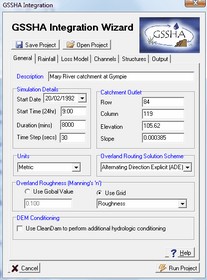
The CatchmentSIM GSSHA interface can now be used to define all of the remaining GSSHA input parameters. To open the GSSHA interface select 'Analysis >> GSSHA'
The first page of the GSSHA interface, which is shown below, allows you to specify general GSSHA input parameters.
The majority of the defaults on this page do not need to be altered. However, information that does need to be modified for each simulation includes:
•Simulation Details; and,
•Overland Roughness (Manning's 'n').
For this example, we will be simulating a flood that occurred in February 1992. Therefore, the 'Simulation Details' should be updated to reflect this:
•Start Date - 20/02/1992
•Start Time - 09:00
•Duration - 8,000
•Time Step - 30
The Overland Roughness section needs to be updated to reference the Roughness grid that we created. Ensure that the "Use Grid" radio button is selected and then select "Roughness" from the drop down box. The completed 'General' page should look like the following:
When developing GSSHA projects of your own, it is generally worthwhile using a global roughness first to get am approximate idea of what sort of global roughness value will generate reasonable results before developing a variable roughness grid. This global value can then serve as a good starting point for setting roughness values for your roughness grid.
Note that the 'Catchment Outlet', 'Units', 'Overland Routing Solution Scheme' and 'DEM Conditioning' section can retain default values. They generally do not need to be modified unless there are instabilities when running the simulation.

